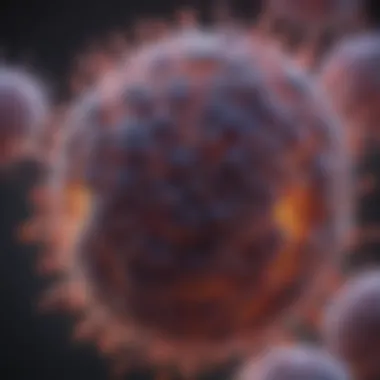Understanding Cancer Grading: A Comprehensive Guide


Intro
Cancer grading is a pivotal concept in oncology that serves as a cornerstone for understanding tumor behavior. At its core, it categorizes tumors based on cellular characteristics, providing crucial insights into how they are likely to develop and respond to treatment. This system of classification allows healthcare professionals to tailor treatment plans to individual patients, enhancing prospects for recovery or management of the disease.
The grading of cancer cells pertains to the differentiation of the cells and how abnormal they appear under a microscope. The more abnormal the cells, the higher the grade, which often correlates with a more aggressive disease course. Understanding cancer grading could mean the difference between a straightforward treatment protocol or more complex, aggressive interventions. Thus, the importance of grasping this topic cannot be overstated, not just for healthcare professionals but for patients who seek to navigate their treatment options with informed awareness.
Key Findings
Summary of the main results
Recent studies shed light on several vital aspects of cancer grading:
- Diverse Grading Systems: Different types of cancer employ various grading systems tailored to their unique biological behaviors. For example, the Gleason score for prostate cancer evaluates patterns of cell growth, while the Nottingham grading system assesses breast cancers.
- Prognostic Value: High-grade tumors generally indicate a worse prognosis. They tend to be associated with a higher likelihood of metastasis and a decrease in overall survival rates.
- Impact on Treatment: Grading influences treatment decisions significantly. Higher-grade cancers may necessitate more aggressive treatments, including chemotherapy or radiation, as opposed to surveillance strategies that may suit lower-grade tumors.
Significance of findings within the scientific community
The findings regarding cancer grading are significant for several reasons. They facilitate more accurate prognostic estimates, enhance patient selection for clinical trials, and inform the development of new therapeutic strategies. As researchers continue to investigate the link between tumor grade and patient outcomes, the medical community can better refine its approaches to treatment, potentially improving survival rates and quality of life.
Implications of the Research
Applications of findings in real-world scenarios
Grading not only informs clinical practice but also extends into the realm of interdisciplinary research. For instance, the collaboration between oncologists, pathologists, and geneticists can lead to a more nuanced understanding of how tumor grade influences behaviors at the molecular level. This collaboration can result in targeted therapies that align with the unique grading of a patient’s tumor.
Furthermore, understanding the relationships between grading and treatment response patterns may improve strategies for managing side effects in therapies tailored for higher-grade tumors, thus enhancing patient care.
Potential impact on future research directions
Looking ahead, research into cancer grading can steer significant advancements in personalized medicine. As new technologies such as next-generation sequencing emerge, researchers are poised to develop even more sophisticated grading systems. These advancements may improve our understanding of tumor heterogeneity, leading to more precise prognostic assessments and therapies tailored to not just the grade, but multiple aspects of tumor biology.
One can envision a future where grading systems evolve based on patient genetics, tumor microenvironment, and treatment history, refining how we understand and combat cancer.
"Understanding tumor grading is not just an academic exercise; it fundamentally changes how we approach care and improve outcomes for patients fighting against cancer."
Intro to Cancer Grading
Cancer grading holds a significant place in oncology, acting as a vital tool for clinicians and researchers alike. The purpose of grading is to offer insights into the behaviors and characteristics of tumors by examining the cells involved. Understanding this concept is crucial—not just for medical professionals, but for patients too, as it profoundly influences treatment pathways and prognostic considerations.
Definition of Cancer Grading
Cancer grading refers to the process of classifying tumors based on their histological characteristics, primarily examining how abnormal the cells appear under a microscope. The vast majority of cancers can be assessed using a grading system that evaluates factors such as cellular differentiation, mitotic activity, and the architecture of the tumor. In simpler terms, grading provides a snapshot of how aggressive a cancer might be, helping in determining the likely progression of the disease. Different types of cancer have developed their own grading systems, tailored to their unique cellular behaviors and growth patterns. For instance, in breast cancer, the Nottingham grading system is widely employed, whereas prostate cancer grading often utilizes the Gleason Score.
Importance of Cancer Grading
The significance of cancer grading cannot be overstated. By determining the grade of a tumor, healthcare professionals can make informed decisions regarding treatment options, enabling a more personalized approach to patient care. Grading not only aids in predicting outcomes but also influences decisions on the urgency of intervention. High-grade tumors tend to grow faster and may metastasize more quickly than lower-grade tumors. Consequently, patients with low-grade tumors might be candidates for active surveillance, while those with high-grade tumors often require immediate and aggressive treatment.
"Understanding the grade of a tumor is like having a roadmap; it guides treatment decisions and helps predict the course of the disease."
Furthermore, effective communication in the clinical setting hinges on a shared understanding of grading systems. It streamlines discussions among doctors, patients, and caregivers, fostering better decision-making and enhancing patient trust.


Historical Context of Cancer Grading
Importance of Historical Context of Cancer Grading
Understanding the historical context of cancer grading is critical for appreciating how these systems have evolved over time. The foundation laid by past practices has paved the way for contemporary grading systems that play an essential role in diagnosis and treatment strategies today. Historical insights allow us to recognize the improvements made in accuracy and reliability in assessing tumor severity, which directly influences patient outcomes. Moreover, knowledge of historical methods sheds light on the enduring challenges that persist in grading, showing that while progress has been made, the road is still bumpy in various aspects of cancer assessment.
Early Methods of Tumor Assessment
In the earlier days of oncology, methods for assessing tumors were rudimentary at best. The approach was often observational and heavily reliant on physical examinations and general symptoms rather than specific pathological analysis. Physicians, often limited by the technology of their time, categorized tumors based primarily on size and location. For instance, doctors might have classified a tumor as benign or malignant based simply on its growth behavior, often leading to subjective interpretations.
One prominent example involved the use of the "Gleason Scale" for prostate cancer. In the 1960s, Dr. Donald Gleason proposed a system to help classify prostate cancer based on histological features. However, prior to his work, substantial variability in tumor identification existed, leading to inconsistent prognostic outcomes. Rather than relying on scored metrics, most malignancies were grouped into broad categories, making it hard to tailor treatment adequately.
As science progressed, there was a gradual shift. Histological techniques developed, allowing pathologists to examine tumor cellular structure under a microscope. This marked a significant leap in the accuracy of tumor classification, although conventional grading would take several more decades to formalize into a systematic and widely adopted practice.
Evolution of Grading Systems
As the field of oncology continually grew, so did the need for more sophisticated grading systems capable of providing clearer prognostic data. The late 20th century bore witness to an emphasis on quantifiable grading. Various systems were established, each aiming to enhance understanding and prediction of tumor behavior and patient's prognosis.
One system that arose was the "Nottingham Prognostic Index" for breast cancer, emphasizing tumor size, lymph node involvement, and histopathological grade as critical determinants. The establishment of these systems marked a paradigm shift; they not only enabled better prediction of outcomes but also allowed oncologists to correlate specific grades with distinct treatment plans.
Additionally, advancements in molecular pathology added another layer of complexity and precision to grading systems. Today, grading combines traditional histopathological features with genomic and molecular markers, representing a fusion of classical and modern science. This evolution reflects a broader trend towards more personalized medicine, where treatments can be adjusted based on the unique characteristics of a patient's tumor.
"The journey from basic tumor assessment to sophisticated grading systems exemplifies the critical nexus between scientific innovation and patient care."
Reflecting on this historical trajectory, it becomes clear that each grading system built upon its predecessors, ultimately leading to an integrated approach that seeks to provide what is arguably the most significant tool for oncologists – reliable and actionable tumor evaluations.
Current Grading Systems
The landscape of cancer grading is multifaceted and pivotal in tailoring appropriate treatment strategies for oncological patients. Current grading systems serve as a bridge between scientific understanding and clinical application, providing healthcare professionals with essential tools for assessing tumor behavior. The reliability of these grading systems is rooted in their ability to distill complex biological data into actionable insights, making them invaluable in both prognostic evaluation and treatment planning.
The Gleason Score
The Gleason Score remains one of the most widely recognized grading systems, chiefly utilized for prostate cancer evaluation. Developed in the 1960s by Dr. Donald Gleason, this score categorizes prostate tumors based on their microscopic structure. It assigns a score from 1 to 5 to two predominant patterns observed in the tumor, yielding a total score ranging from 2 to 10. Higher scores indicate more aggressive disease, reflecting the likelihood of metastasis and recurrence.
The prognostic significance of the Gleason Score cannot be overstated. For instance, a Gleason score of 6 or below generally suggests a less aggressive tumor, often leading to a conservative management approach. Conversely, a score of 8 or higher typically necessitates more aggressive treatment, such as surgery or radiation. This scoring system has been instrumental in shaping treatment protocols, guiding patient discussions, and stratifying risks effectively within clinical settings.
The Nottingham Prognostic Index
The Nottingham Prognostic Index is another noteworthy grading system, predominantly applied to breast cancer. This index incorporates tumor size, lymph node status, and histological grade, creating a composite score that stratifies patients into low, intermediate, and high risk for disease recurrence.
- Size of the tumor: Measured in centimeters, larger tumors correlate with worse prognoses.
- Lymph node status: The presence of cancer in lymph nodes signals increased aggressiveness.
- Histological grade: Serves to assess tumor differentiation, with poorly differentiated tumors being associated with poorer outcomes.
By integrating these factors, the Nottingham Prognostic Index empowers clinicians to make informed decisions regarding treatment modalities. For example, a patient evaluated as high-risk may require adjuvant chemotherapy post-surgery, whereas low-risk patients could be managed with less aggressive surveillance.
Other Notable Grading Systems
In addition to the Gleason Score and Nottingham Prognostic Index, various systems cater to specific tumor types, enriching the grading framework in oncology. Some notable mentions include:
- The Fuhrman Grade: Primarily used for renal cell carcinoma, this grading system assesses nuclear features with scores ranging from 1 to 4, wherein higher grades suggest more aggressive tumor behavior.
- BIRADS Classification: Utilized in breast imaging reports, this system categorizes the level of suspicion for malignancy based on imaging findings and is instrumental for radiologists when screening.
- The AJCC Staging System: While not a grading system per se, it complements grading systems by providing a broader context regarding tumor size, regional lymph nodes, and metastasis, thus guiding overall management.
These grading systems highlight the ongoing efforts to refine the criteria by which oncologists assess tumors. They ensure that grading goes beyond mere categorization, becoming a dynamic part of personalized patient care.


"The integration of various grading systems highlights the complexity of cancer behaviors, providing a more tailored approach to treatment. Understanding these differences is crucial for any healthcare professional engaged in oncology."
Grading Criteria and Methodologies
The criteria and methodologies applied in cancer grading are pivotal. They not only aid in understanding the nature and severity of tumors but also provide a foundation for deriving treatment strategies. The effectiveness of any grading system hinges on its criteria, with histopathological techniques and molecular factors forming the backbone of these evaluations. A solid grasp of these methodologies ensures oncologists can make informed decisions about patient care, which can significantly influence outcomes and prognoses.
Histopathological Techniques
Histopathological techniques are at the forefront of cancer grading. Simply put, they involve examining tissue samples under a microscope to observe cellular features that indicate tumor behavior. Pathologists consider numerous histological characteristics, such as cell size, shape, arrangement, and the degree of abnormality.
Key elements of histopathological grading include:
- Dysplasia assessment: This evaluates how much the cancer cells diverge from normal cells. The greater the difference, the higher the grade.
- Mitotic activity: This refers to the frequency of cell division, where a higher rate suggests a more aggressive tumor.
- Necrosis presence: Areas where tumor cells have died can indicate fast growth outpacing their blood supply.
This meticulous process allows for a nuanced understanding of tumor biology but isn't without its challenges. Variability in interpretation among pathologists can lead to discrepancies in grading.
"While histopathology remains the gold standard, the subjective nature of interpreting slides can introduce variations that are critical in patient outcomes."
Molecular and Genetic Factors
In today’s rapidly evolving landscape of oncology, molecular and genetic factors are increasingly recognized for their relevance in cancer grading. Rather than merely focusing on the visual characteristics of cancerous tissues, these methods delve deeper into the genetic makeup of tumors. By understanding the molecular alterations within a tumor, oncologists can glean important insights into its behavior and potential response to therapies.
Some key factors include:
- Genomic profiling: Techniques such as next-generation sequencing allow for comprehensive assessments of mutations prevalent in different cancers, thus helping to classify tumors at a molecular level.
- Biomarkers: Specific proteins or genetic changes can serve as indicators of the tumor’s grade and its expected response to treatment. For example, the presence of certain mutations in the TP53 gene is often associated with more aggressive forms of cancer.
- Transcriptomic analysis: By examining the RNA expression patterns within tumor cells, researchers can identify the underlying processes driving tumor growth and metastasis.
Combining molecular data with traditional histopathological evaluations ultimately enhances the grading precision and supports personalized medicine approaches, tailoring treatments to the unique genetic profile of each tumor.
Implications of Cancer Grading
Understanding the implications of cancer grading is essential for multiple facets of oncology. Essentially, grading serves not just as a means of categorization, but rather as a cornerstone for clinical decision-making, patient management, and understanding disease behavior. The information revealed through grading influences both short-term and long-term outcomes for patients.
Prognostic Value of Grading
The prognostic value of grading cannot be overstated. It provides invaluable insights into the likely progression of the disease. For example, a tumor with a high grade often indicates aggressive behavior, which may lead to a more serious prognosis than a low-grade tumor. Research continuously highlights the significance of distinguishing these grades. Studies have shown that patients with higher-grade tumors tend to experience more rapid deterioration.
Moreover, when considering treatment outcomes, grading becomes a vital statistic. For instance, the Gleason score, particularly relevant for prostate cancer, serves as a benchmark for evaluating prognosis and guiding treatment decisions. Higher Gleason scores correlate with increased risks, guiding oncologists toward more intensive treatments. Ultimately, grading systems like this help transform clinical findings into actionable intelligence for patient care.
Treatment Decisions and Strategies
Cancer grading plays a pivotal role in guiding treatment decisions. Graded tumors typically dictate whether a certain treatment approach is appropriate. In many instances, low-grade tumors might be monitored through active surveillance rather than treated immediately. Such a strategy can spare patients from the potential side effects of aggressive treatment and thus improve their quality of life.
In contrast, high-grade tumors may necessitate swift surgery, chemotherapy, or radiation therapy, designed to counteract their increased aggressiveness.
Consider the following:
- Personalized Treatment Plans: Oncologists develop tailored treatment strategies based on the grade of the tumor, which aligns with the patient's specific risk profile.
- Multi-disciplinary Approach: Collaboration among specialists, including pathologists, oncologists, and radiologists, hinges on grading as they devise comprehensive treatment strategies.
The integration of grading into treatment protocols enables healthcare providers to adapt their approaches based on evolving research and clinical evidence. It’s a continuous effort to fine-tune methods, helping to ensure that patients receive the best possible care.


A nuanced understanding of cancer grading can empower healthcare professionals in making informed, judicious decisions that directly affect the health trajectory of their patients.
Challenges in Cancer Grading
Cancer grading plays a crucial role in how oncologists interpret tumor characteristics and predict disease behavior. Yet, while it's a necessary tool, there are significant challenges that can complicate the grading process. Understanding these hurdles not only sheds light on the grading's reliability but also highlights the areas where advancements can improve patient outcomes.
Interobserver Variability
One of the most pressing issues in cancer grading is interobserver variability, which refers to the differences in grading results between pathologists. Various factors contribute to this inconsistency, including individual expertise, experience levels, and subjective interpretation of histological features. For instance, a pathologist may view a tumor's cell architecture and make a different grading decision than another despite examining the same slide. This discrepancy in judgment can lead to varying treatment strategies for patients, impacting their prognoses significantly.
"The subjective nature of cancer grading can alter treatment pathways, which makes consensus and standardization vital for optimal care."
Some research indicates that even well-trained professionals can differ in their assessments. Factors such as fatigue during slide reviews or differences in institutional protocols can also play a role. Recent studies suggest that employing standardized grading criteria and rigorous training may help alleviate this variability, but it remains a challenge that demands ongoing attention.
The Role of Artificial Intelligence
Another frontier in tackling the challenges of cancer grading lies in the integration of artificial intelligence (AI). AI and machine learning technologies promise to bring precision and consistency to histopathological analysis. When implemented effectively, AI can analyze large datasets, recognizing patterns in tumor cells that might be missed by human eyes. These technologies can assist pathologists by providing second opinions or even suggesting potential grades based on vast libraries of training data.
The use of AI also allows for greater standardization in grading, reducing the influence of individual biases and interpretations. While there's a growing body of evidence supporting AI's efficacy, it isn't without its challenges. Data privacy, ethical considerations surrounding AI application, and the need for rigorous validation in clinical settings are all critical factors that must be addressed.
The Future of Cancer Grading
The domain of cancer grading is at a critical juncture, where advancements in research and technology are shaping the way tumors are understood and categorized. As medical science evolves, the relevance of effectively grading cancer grows, not just for prognostic purposes, but for tailoring treatment strategies that address the unique characteristics presented by each tumor. This section will explore emerging research trends and the concept of personalized medicine, both of which are crucial in delineating the future landscape of cancer grading.
Emerging Research Trends
There's a notable shift in the cancer research paradigm, moving from a one-size-fits-all approach towards a more nuanced understanding of tumor biology. Recent studies are emphasizing the importance of molecular profiling and genomic sequencing.
- Tumor Heterogeneity: Research has begun to reveal that tumors are not uniformly the same, even within a single patient. Some may look similar under the microscope but behave quite differently. Understanding this heterogeneity allows oncologists to grade tumors more effectively.
- Real-World Data: The integration of real-world evidence from patient records is becoming a powerful tool. By analyzing outcomes from large populations, researchers can refine grading systems to better reflect the actual behavior of tumors in diverse patient groups.
- Biomarker Discovery: The identification of new biomarkers continues to be a fertile ground for future research. These indicators could provide insights into a tumor's potential for aggression and its response to various therapies, thus impacting grading.
"The future of cancer grading lies in our ability to look beyond traditional histopathology and embrace the plethora of data at our fingertips."
Personalized Medicine and Grading
The notion of personalized medicine is gradually permeating cancer treatment protocols. Tailoring treatment based on individual tumor characteristics necessitates an evolution in grading systems. In fact, as we inch closer to personalized approaches, effective grading can lead to significantly improved patient outcomes.
- Targeted Therapies: Customized treatments that focus on specific molecular characteristics of a cancer are on the rise. If grading systems can accurately capture these characteristics, it may result in more effective treatment plans being deployed.
- Patient-Centric Models: As healthcare shifts towards models that prioritize patient experiences and outcomes, grading becomes integral. It is no longer just about categorizing tumors; it’s about understanding the patient’s cancer journey and how they respond to treatment based on their tumor grade.
- Integration with AI and Machine Learning: The involvement of artificial intelligence in pathology is becoming increasingly vital. Algorithms can provide rapid and detailed analysis, which can support oncologists in making grading decisions that align with personalized treatment strategies.
The future of cancer grading holds significant potential, as it merges innovative research with the intricacies of individual patient care. The road ahead is one that blends cutting-edge science with compassion.
Finale
In the world of oncology, the importance of cancer grading cannot be overstated. It serves as a pivotal benchmark that influences nearly every aspect of patient care, from diagnosis to treatment strategies. A precise grading system offers a window into the aggressive nature of a tumor, helping healthcare professionals to tailor therapies that are not only effective but also proportionate to the malignancy's potential threat. By classifying cancer based on cellular traits, grading equips clinicians with vital information that can dictate the course of treatment, ensuring that patients receive appropriate care tailored to the specifics of their condition.
Summarizing the Importance of Accurate Grading
Accurate cancer grading is crucial in determining prognosis and treatment pathways. Simply put, when oncologists correctly gauge the grade of a tumor, they can better predict its behavior. High-grade tumors often indicate more aggressive disease, demanding vigilance and often more extensive treatment plans. Meanwhile, low-grade tumors might allow for a less invasive approach. This discernment not only optimizes patient outcomes but also alleviates unnecessary anxiety that may arise from overtreatment or mismanagement of less aggressive cancers. For instance, patients diagnosed with a Grade 1 tumor can focus on lifestyle modifications and routine monitoring instead of aggressive therapies.
Moreover, an accurate grading system fosters improved communication among healthcare providers. Clear definitions and standards provide a common language that doctors and nurses can use to convey important information about a patient's condition, thus enhancing collaborative care. As patients journey through their treatment, understanding their tumor grade becomes paramount in navigating discussions around their prognosis, follow-up care, and support options.
Call for Ongoing Research and Education
The landscape of cancer grading is dynamic, with continuous advancements in research paving the way for more refined and reliable grading systems. There is a clear need for ongoing studies that explore the biological markers warranting consideration in grading, as tumor behavior can vary significantly even among similarly graded cancers. Further education for both medical professionals and the public is crucial to keep pace with the evolutions occurring in oncology. As novel treatments emerge and grading techniques are refined, it is vital that oncologists engage in lifelong learning to maintain proficiency and provide the best possible care.
Additionally, while artificial intelligence holds promise for enhancing grading accuracy, it remains essential to understand its limitations within clinical practice. Ongoing discourse about the roles of human judgment versus technological advances in grading will shape future methodologies.
In essence, grappling with the challenges of cancer grading isn’t merely an academic pursuit; it has tangible implications for lives at stake. The call for further research and education serves as a reminder that while we’ve come far, there is always more ground to cover in the quest for precise cancer grading.







